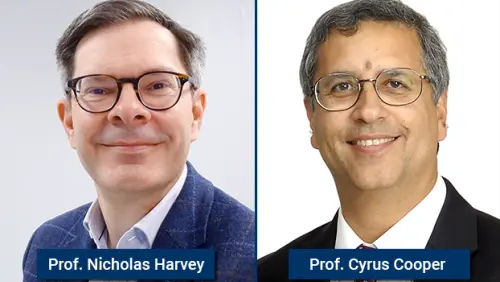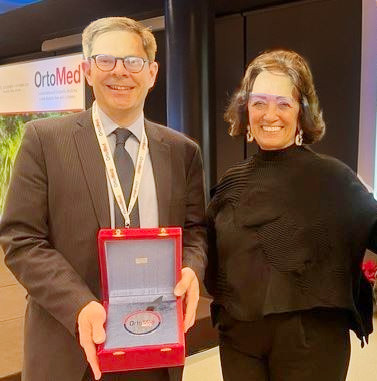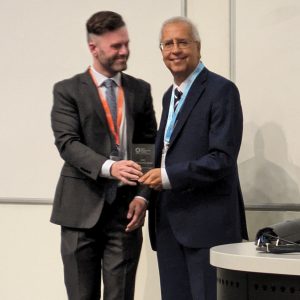[vc_row][vc_column][vc_column_text]UK health and social care costs due to muscle weakness amount to around £2.5 billion according to a new study carried out at the University of Oxford and the University of Southampton.
Scientists from the Botnar Research Centre (University of Oxford) and the Medical Research Council Lifecourse Epidemiology Unit (MRC LEU, University of Southampton) examined the health and social care costs for individuals with and without muscle weakness who participated in the Hertfordshire Cohort Study (442 men and women, aged 71-80 years).
Muscle weakness and sarcopenia (accelerated loss of muscle mass and strength) are common among older people and are associated with higher risks of disability, frailty and premature death. They can also result in loss of independence and ability to perform the tasks of daily living.
The study, published in Calcified Tissue International and Musculoskeletal Research, showed that, on average, individuals with muscle weakness had health and social care costs that were £2707 per year higher than individuals without muscle weakness. This resulted in excess costs associated with muscle weakness of £2.5 billion per year for health and social care and £1.3 billion for health care alone.
In addition, the study found that a large proportion of the total excess costs (46%) was due to informal care (a valuation of the unpaid time family members and friends spent providing domestic or personal care at home).
Lead author, Dr Rafael Pinedo-Villanueva, Senior Researcher in Health Economics at the University of Oxford, highlighted that “with this study we not only estimate how much it costs the healthcare system and society in general to care for older adults with muscle weakness, but we also gain a better understanding about the healthcare services they receive, and their reliance on friends and family for the provision of care at home, which is often overlooked when assessing the economic burden of health conditions.”
Muscle weakness was characterised using low grip strength (<26kg among men, <16kg among women) which was measured using a dynamometer. Grip strength is associated with upper body and overall strength. Information on primary care and hospital appointments, medications, as well as paid and unpaid care for each participant was obtained through questionnaires.
Professor Cyrus Cooper, Director of the MRC LEU, said: “Sarcopenia in older age is now recognised as a major public health problem. Lifestyle factors such as poor diet and physical inactivity as well as low birth weight (indicative of poor foetal environment) contribute to this condition. The substantial costs of muscle weakness demonstrate the importance of developing strategies to promote maintenance, and reduce loss, of strength in later life.”
Ends[/vc_column_text][vc_column_text el_class=”reflist”]Notes for editors
- The paper, Health Care Costs Associated With Muscle Weakness: A UK Population-Based Estimate, is published in Calcified Tissue International and Musculoskeletal Research,
DOI: https://link.springer.com/article/10.1007/s00223-018-0478-1 - The study was funded by the following organisations: Medical Research Council; British Heart Foundation; Arthritis Research UK; International Osteoporosis Foundation; NIHR Southampton Biomedical Research Centre; NIHR Oxford Biomedical Research Centre; University of Southampton.
- The University of Southampton drives original thinking, turns knowledge into action and impact, and creates solutions to the world’s challenges. We are among the top one per cent of institutions globally. Our academics are leaders in their fields, forging links with high-profile international businesses and organisations, and inspiring a 24,000-strong community of exceptional students, from over 135 countries worldwide. Through our high-quality education, the University helps students on a journey of discovery to realise their potential and join our global network of over 200,000 alumni. www.southampton.ac.uk
- The Medical Research Council is at the forefront of scientific discovery to improve human health. Founded in 1913 to tackle tuberculosis, the MRC now invests taxpayers’ money in some of the best medical research in the world across every area of health. Thirty-two MRC-funded researchers have won Nobel prizes in a wide range of disciplines, and MRC scientists have been behind such diverse discoveries as vitamins, the structure of DNA and the link between smoking and cancer, as well as achievements such as pioneering the use of randomised controlled trials, the invention of MRI scanning, and the development of a group of antibodies used in the making of some of the most successful drugs ever developed. Today, MRC-funded scientists tackle some of the greatest health problems facing humanity in the 21st century, from the rising tide of chronic diseases associated with ageing to the threats posed by rapidly mutating micro-organisms. www.mrc.ac.uk
- The Nuffield Department of Orthopaedics, Rheumatology and Musculoskeletal Sciences (NDORMS) is a multi-disciplinary department focusing on discovering the causes of musculoskeletal and inflammatory conditions to deliver excellent and innovative care that improves people’s quality of life. The largest European academic department in its field, NDORMS is part of the Medical Sciences Division of the University of Oxford, and is a rapidly growing community of more than 400 orthopaedic surgeons, rheumatologists and scientists all working in the field of musculoskeletal disorders. The research work of the department takes place in several locations across the Nuffield Orthopaedic Centre, namely the Botnar Research Centre, and the Kennedy Institute of Rheumatology. The co-location with NHS services puts the department in an excellent position with basic researchers working alongside clinicians. This substantially improves research capacity, improving access for researchers to patients, and facilitating the interaction between clinicians and scientists that is essential for successful medical research. www.ndorms.ox.ac.uk
- The NIHR Oxford Biomedical Research Centre (BRC) is based at the Oxford University Hospitals NHS Foundation Trust and run in partnership with the University of Oxford. The aim of the National Institute for Health Research (NIHR) is to improve the health and wealth of the nation through research. Established by the Department of Health, the NIHR:
- funds high quality research to improve health
- trains and supports health researchers
- provides world-class research facilities
- works with the life sciences industry and charities to benefit all
- involves patients and the public at every step
For further information, visit the NIHR website www.nihr.ac.uk.[/vc_column_text][/vc_column][/vc_row]








